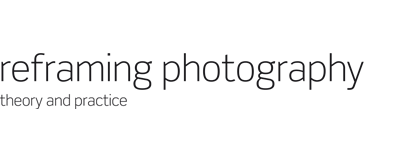Non-Silver & Historic Printing Processes
Non-silver and historic processes are general terms that refer to various photographic processes that do not contain silver in its emulsion or were popular around the turn of the 20th century. Invented during the latter half of the 19th century, these older processes include collodion wet-plate, van dyke brown, gum-bichromate, and cyanotype, among others. Each requires mixing and coating the emulsion by hand. Hence, the resulting images have a painterly quality, an effect often left from the brushstrokes in painting the emulsion and the small inconsistencies and inaccuracies that result from hand processing.
In the 1960s and 70s, research into antique photographic processes unearthed descriptions of these techniques, which had not been in use since gelatin silver printing became dominant. It is unclear what led to this revival. Some accounts claim that photographers documenting Civil War reenactments wanted to subscribe to the same level of historic accuracy as the participants “fighting” the battles. Photography was also starting to gain greater acceptance as a fine art form during this period and many artists were attracted to the experimental nature of historic processes. Revivalist practitioners rewrote the recipes for historic formulas from the language of the 19th century for a contemporary audience. The books and online sources in our resources guide describe the processes of making Van Dyke Brown, gum bichromate, cyanotype and other print positives.
Printing Facilities and Safety
Each process has specific needs and safety requirements. The following techniques are all contact printing processes; the size of the print will be the same size of the negative. These processes require an ultraviolet (UV) light source. Common sources are the sun, full spectrum or plant growth fluorescent lamps, sunlamps and mercury vapour lamps. There are many variables to consider if making exposures with the sun, including consistency and intensity. While sunlight is readily available, it varies according to the time of day and year and the weather conditions. UV bulbs may ensure more consistent results. Other facilities and equipment needs are minimal. Working with solutions requires a dimly lit space.
Chemicals, especially dry chemicals and silver, may be toxic, cause staining or burns and should be handled only when wearing gloves, goggles and a respirator. We provide details about chemical safety for cyanotype, but chemical and toxicity information on the other chemicals usually accompany the purchase of this chemistry, can be located at manufacturers’ websites or can be found by reading the resources we recommend for Historic Processes.
Van Dyke Brown
Van Dyke or Brown prints have deep brown tones characteristic of work by the 17th century Flemish painter Anthony Van Dyck, hence the name. The VanDyke Brown print process originated around 1840 through astronomer and chemist J.F.W. Herschel's research with iron sensitizers. The Van Dyke emulsion can be applied to most kinds of paper and natural fabric and requires minimal chemistry and equipment. Negatives can be contact printed onto the sensitized Van Dyke material. Once the emulsion is mixed, it can last for several months in a dark bottle. Material that has been coated should be exposed and processed within a day, although there are reports of waiting several weeks with minimal difficulty.
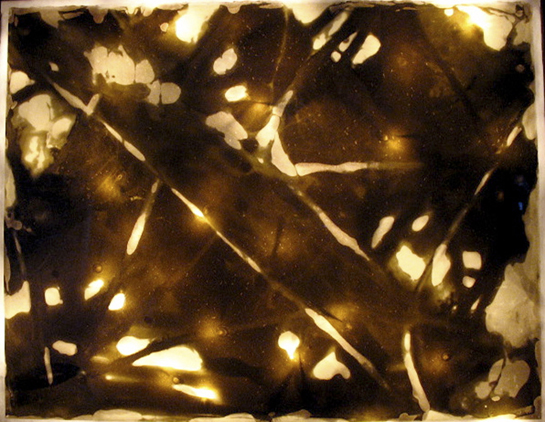 photo: Amanda Norenberg, Molecular #1, Van Dyke Brown, white beeswax, paper, made from hand-printed ortho-litho negative, 20”x16”, 2006. Norenberg imagines a system of energetic cells connecting our souls to our bodies. To visualize these shapes, she photographs string and wire sculptures and prints the images in Vandyke on rice paper.
photo: Amanda Norenberg, Molecular #1, Van Dyke Brown, white beeswax, paper, made from hand-printed ortho-litho negative, 20”x16”, 2006. Norenberg imagines a system of energetic cells connecting our souls to our bodies. To visualize these shapes, she photographs string and wire sculptures and prints the images in Vandyke on rice paper.
Gum Bichromate
Gum bichromate (aka gum printing or bichromate process) is a non-silver printing method that uses emulsion made up of a colloid (such as gum arabic or albumen) made light sensitive with a dichromate (such as potassium or ammonium bichromate). Once the sensitized bichromate is applied to a sheet of paper, a negative can be contact printed onto the paper. The combination of a colloid and a dichromate (also called a bichromate) is called a chromated colloid. Alphonse Louis Poitevin, a French chemist, is credited with discovering the light sensitivity of chromated colloids in 1855. John Pouncy, an Englishman, took Poitevin's discovery and developed the gum process sometime between 1856 and 1859. The process reached its greatest point in popularity around 1900.
The uniqueness of the gum bichromate process lies in the addition of watercolor pigment, of any color, to the emulsion. While the color of other photographic processes, such as cyanotype, is a result of the emulsion’s chemical reaction, a gum print’s color is determined by the addition of pigment. Multiple colors, even up to CMYK full color printing, can be produced by re-coating the paper several times between exposures. Printing with multiple colors is a more elaborate process, requiring separate negatives for each color used. Gum prints can also be brushed during the wash to add a sense of texture and a painterly effect. Creation of the image begins by printing the negative and continues afterward with the possible addition of more color and brushwork. Gum bichromate prints have a soft and long tonal range without fine detail.
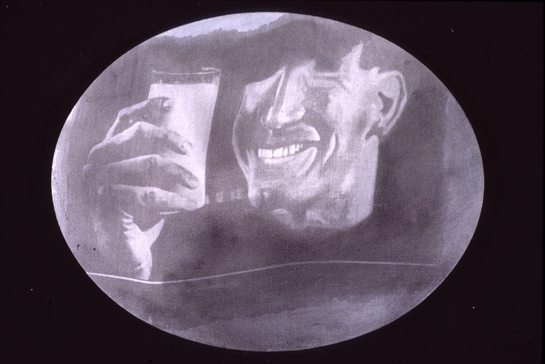 photo: Pierre Gour. detail of Man Drinking Milk. 2005. gum bichromate on canvas.
photo: Pierre Gour. detail of Man Drinking Milk. 2005. gum bichromate on canvas.
Collodion or Wet-Plate Process
Collodion wet-plate negatives are made with light-sensitive silver nitrate, unlike the silver chloride or silver bromide mixture in contemporary gelatin-silver based photography. When exposed to light and then processed, the emulsion in most photographic processes becomes visible and changes color. The collodion’s silver nitrate turns black. The wet collodion process is meant for negatives, although the process can also be used to make unique positives that cannot be reproduced.
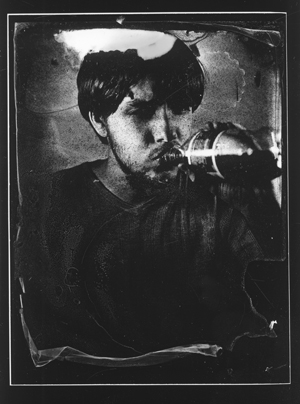
photo: Shanna Nash, Drink-up, Jeff, wet-collodion negative printed on black-and-white fiber-based paper, 20x24”, 2005. In its heyday, wet-collodion portraits required long exposures. The effort of sitting still and the formal nature of portraiture meant that sitters posed with a straight, somber expression. In her sittings, Nash floods the scene with powerful lights. The shorter exposure times encourage her subjects to present contemporary activities and expressions.
Collodion combined with silver nitrate is a light-sensitive coating; the collodion solution can be coated on glass to make negatives or used in positive processes, such as ambrotypes and tintypes. In the collodion wet-plate process, guncotton, alcohol and ether mix to produce collodion, a clear and viscous fluid that dries quickly. Formulated in 1846, the mixture made a perfect liquid bandage for dressing wounds during the Crimean War (1854-56). Frederick Scott Archer reformulated the solution for photographic purposes in 1851. Collodion coated on a glass plate, sensitized and exposed, yielded a transparent negative that replaced the costly and irreproducible daguerreotype and the paper negative of the calotype. From the 1850s through the 1870s, the process was used for such diverse purposes as making negatives documenting the Civil War or elaborate scenes and portraits in the style of allegorical paintings.
Collodion negatives have the finest grain of any silver-based film and can be enlarged to make big prints on contemporary silver-gelatin paper without loss of detail. Images show fine texture and wide tonal range and, due to the emulsion's thick consistency, sometimes have smooth streaks or bubbles. The wet collodion process can also be used to make a unique, irreproducible positive, known as an ambrotype. An ambrotype is essentially a wet-plate positive exposed with less light (to be thin) and developed with diluted developer and placed on top of black paper or velvet. The black backing creates shadow areas, while the negative's silver produces the highlight areas, resulting in a positive image. Ambrotypes have a ghostly quality similar to daguerreotypes due to the reflective glass surface.
The collodion wet-plate process
The wet-plate collodion process is not for beginners. Collodion is hazardous and explosive chemistry and it is reported that many early practitioners demolished their darkrooms or lost their lives due to careless handling.
Cyanotype
The cyanotype process is considered to be the simplest of all the historic processes. It can be used to make contact prints from negatives (the final image will be the same size as the negative), or photograms. It is iron-based, just as the Van Dyke Brown process, but characterized by deep blue tones. J.F.W. Herschel discovered cyanotype's basic chemical components: potassium ferricyanide and ferric ammonium citrate.
While we recommend the traditional cyanotype process below, this “historic” technique is still evolving as practitioners seek chemical improvements or new aesthetic qualities. For example, the “New” Cyanotype process by Mike Ware is an updated process that offers an exposure time significantly shorter than the traditional processes and with less risk that the blue tone will rinse away in the “developing” stage. However, this new version is fairly difficult and toxic to prepare, requiring careful attention to handling. The traditional process is far less complicated to mix and safe enough that Photographer’s Formulary claims that children can work with the working solutions of chemicals. Both the traditional and the new process can be practiced using kits available from Photographer's Formulary. A detailed procedure is available at www.photoformulary.com/uploads/07-0090.doc.
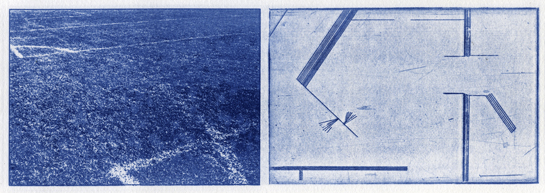 photo: Toby Millman. Tribute to Sakhnin. 2005. Cyanotype. The Sakhnin soccer team, with a squad of 12 Palestinians, seven Jewish-Israelis, and four foreigners, is a symbol of coexistence. With the smallest budget in the Israeli premier league and the least support, the team still managed to win the Israel State Cup in 2004. In her Tribute to Sakhnin, Millman used the cyanotype process to juxtapose a photograph of a soccer field with a line etching that resembles a blueprint of a house. Each plan symbolizes borders, movement and homeland.
photo: Toby Millman. Tribute to Sakhnin. 2005. Cyanotype. The Sakhnin soccer team, with a squad of 12 Palestinians, seven Jewish-Israelis, and four foreigners, is a symbol of coexistence. With the smallest budget in the Israeli premier league and the least support, the team still managed to win the Israel State Cup in 2004. In her Tribute to Sakhnin, Millman used the cyanotype process to juxtapose a photograph of a soccer field with a line etching that resembles a blueprint of a house. Each plan symbolizes borders, movement and homeland.
Tools, materials and equipment
• Cyanotype kit from Photographer's Formulary (model #07-0090, includes instructions and all necessary chemistry)
• a negative (for contact printing) OR an object (for a photogram)
• heavyweight acid free paper (extra paper for test sheets)
• a bristle OR foam brush
• two dark brown storage containers (with a capacity of 500 ml)
• several small beakers OR measuring cups for mixing
• mixing spoons
• a dropper for measuring ml
• sunlight OR a UV light source (the Cyanotype kit recommends a General Electric 275 or 300-watt sunlamp, but any UV light unit will work)
• a contact printer OR sheet of glass
• water (for best results, distilled water is recommended)
• optional: a dark container with a capacity of 100 ml (for Potassium dichromate which can be added to a working solution for high contrast printing. It is included in the kit from Photographer's Formulary and is described in the kit's instructions)
• optional: a hairdryer with a cool setting (to speed drying time)
Safety and handling
While Potassium ferricyanide contains cyanide and could cause irritation to the skin, it’s toxicity for chronic health concerns is not known. Potassium dichromate is both toxic and an oxidizer. To dispose of excess solid potassium dichromates, always wash the solid down a drain with abundant amounts of water. Never dispose of the solid in a wastepaper basket. Spillage of a dichromate solution on the skin will cause a chemical burn, which will appear as ulceration. In addition, all chromium salts are potential carcinogens. Wear disposable rubber gloves when handling this compound or its solutions. Clean all trays and containers thoroughly with soap and water.
Printing-Out Paper
Invented in the 1880's to replace albumen papers, Printing-Out Paper has a rich tonal range, an historical color palette (red-browns that can be toned towards dark purples), and the ability to be sensitized by the sun. Printing-Out Paper (also referred to as P.O.P.) is a contact-printing process which, due to its devoted following, is still in manufacture and available through distributors of photographic supplies. (SUGGESTED READINGS/RESOURCES/GLOSSARY web-2 HERE)
As the P.O.P. darkens during the exposure process, dark areas of the print block additional light from hitting the paper: this self-masking allows lighter areas to catch up. In this way, Printing-Out Papers automatically, internally, adjust their own contrast. During exposure, the P.O.P. image may be monitored to check its progress - for this reason, a split-back printing frame is recommended.
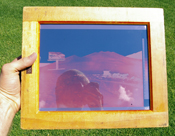
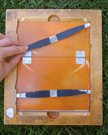
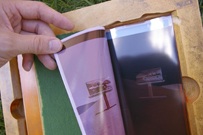
After exposure and a quick water rinse, the P.O.P. may be toned towards a chocolate-brown or a cool eggplant hue, or kept at its (untoned) orange color. The manufacturer recommends toning with an Ammonium Thiocyanate / Gold-Chloride solution (included in Chicago Albumen Work's P.O.P. starter kit), although the Ammonium Thiocyanate may be substituted with other chemicals.
Next, the paper must be fixed with plain hypo (Sodium Thiosulfate) or a hardening fixer such as Kodak Fixer (also included in the starter kit). Do not use a rapid fixer, which will bleach Printing-Out Paper and ruin the print.
Finally, clear the hypo with fixer remover, wash, and dry the print. Flatten the dry print.
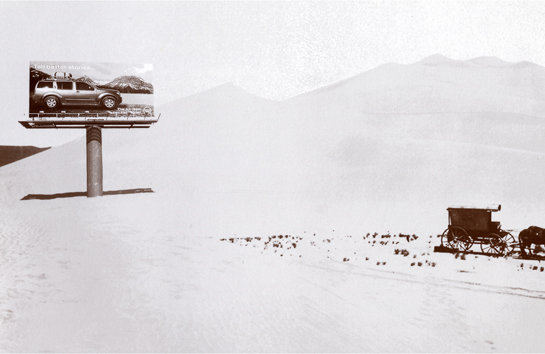 photo: Charles Fairbanks. Tell Better Stories (after Timothy O’Sulivan). 5”x7”. Printing-Out Paper print. 2006.
photo: Charles Fairbanks. Tell Better Stories (after Timothy O’Sulivan). 5”x7”. Printing-Out Paper print. 2006.
Printing-Out Paper should be refrigerated or frozen for long-term storage, but can be stored at room temperature (around 70˚ F or 21˚ C) for up to a year.
Historic Processes Resources
BOOKS:
Christopher James, The book of alternative photographic processes (Clifton Park, NY: Delmar Cengage Learning, 2009), 2nd edition.
John Barnier, Coming into Focus: a step-by-step guide to alternative photographic printing processes (San Francisco, CA: Chronicle Press, 2000).
David Scopick, The Gum Bichromate Book: non-silver methods for photographic printmaking. 2nd ed. (Boston, Mass.; London : Focal Press, 1991).
Bea Nettles, Breaking the Rules: A Photo Media Cookbook, 3rd edition (Urbana, Illinois: Inky Press Productions, 1992). Includes recipes for Cyanotype, Van Dyke Brown Printing, Gum Bichromate and others.
Mike Ware, Cyanotype : the history, science and art of photographic printing in Prussian blue (London : Science Museum ; Bradford [England] : National Museum of Photography, Film & Television, 1999).
Lyle Rexer, Photography’s Antiquarian Avant-Garde: the new wave in old processes (New York: Harry N. Abrams, 2002).
Jan Arnow, A Handbook of Alternative Photographic Processes (New York: Van Nostrand Reinhold, 1982).
INTERNET:
Alternative Photography
Articles, recipes and technical information about alternative photography processes.
http://www.alternativephotography.com/
Photographers’ Formulary
A source for chemistry, nonsilver processing kits, supplies, technical support and workshops.
http://www.photoformulary.com/
Rockland Colloid Corp.
A source of nonsilver processing kits.
http://www.rockaloid.com/
Bostick & Sullivan
A source for camera equipment, chemistry, books, and other technical information.
http://www.bostick-sullivan.com/
The World Journal of Post-Factory Photography, Issue #1, 1998
downloadable at http://www.alternativephotography.com/
Printing-Out Paper Resources
SUPPLIERS
For P.O.P. in the United States, contact the Chicago Albumen Works
www.albumenworks.com
